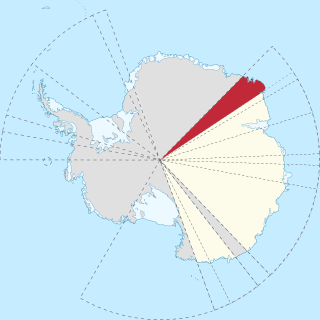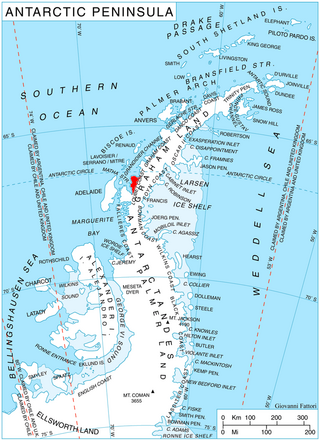Related Research Articles

The Priestley Glacier is a major valley glacier, about 60 nautical miles long, originating at the edge of the Polar Plateau of Victoria Land, Antarctica. The glacier drains southeast between the Deep Freeze Range and Eisenhower Range to enter the northern end of the Nansen Ice Sheet. It was first explored by the Northern Party of the British Antarctic Expedition, 1910–13, and named for Raymond Priestley, a geologist with the Northern Party.
The Anare Mountains are a large group of mainly snow-covered peaks and ridges along the northern coast of Victoria Land, Antarctica. The group is bounded on the north and east by the Pacific Ocean, on the west by Lillie Glacier, and on the south by Ebbe Glacier and Dennistoun Glacier. They are north of the Concord Mountains and east of the Bowers Mountains.

The Prince Charles Mountains are a major group of mountains in Mac. Robertson Land in Antarctica, including the Athos Range, the Porthos Range, and the Aramis Range. The highest peak is Mount Menzies, with a height of 3,228 m (10,591 ft). Other prominent peaks are Mount Izabelle and Mount Stinear. These mountains, together with other scattered peaks, form an arc about 420 km (260 mi) long, extending from the vicinity of Mount Starlight in the north to Goodspeed Nunataks in the south.

Enderby Land is a projecting landmass of Antarctica. Its shore extends from Shinnan Glacier at about 67°55′S44°38′E to William Scoresby Bay at 67°24′S59°34′E, approximately 1⁄24 of the earth's longitude. It was first documented in western and eastern literature in February 1831 by John Biscoe aboard the whaling brig Tula, and named after the Enderby Brothers of London, the ship's owners who encouraged their captains to combine exploration with sealing.
Athos Range is the northernmost range in the Prince Charles Mountains of Mac. Robertson Land, Antarctica. The range consists of many individual mountains and nunataks that trend east–west for 40 miles (64 km) along the north side of Scylla Glacier.
Wilson Hills is a group of scattered hills, nunataks and ridges that extend northwest–southeast about 70 nautical miles between Matusevich Glacier and Pryor Glacier in Antarctica.
The Australian Antarctic Names and Medals Committee (AANMC) was established to advise the Government on names for features in the Australian Antarctic Territory and the subantarctic territory of Heard Island and the McDonald Islands. The committee also issues nominations Governor General for the award of the Australian Antarctic Medal.
Debussy Heights is a minor mountain range rising to 1,300 metres (4,300 ft) east of Mozart Ice Piedmont in the north part of Alexander Island, Antarctica. The feature was first spotted and mapped, from air photos taken by the Ronne Antarctic Research Expedition, 1947–48, by D. Searle of the Falkland Islands Dependencies Survey in 1960, and was named by the UK Antarctic Place-Names Committee after Claude Debussy, the French composer (1862–1918).
The McCuddin Mountains are a small cluster of mountains in Antarctica consisting mainly of two large mountains, Mount Flint and Mount Petras, along with several scattered peaks and nunataks. Located in Marie Byrd Land, 64 km (40 mi) east of the Ames Range, with Wallace Rock as its southeast extremity.
All-Blacks Nunataks is a group of conspicuous nunataks lying midway between Wallabies Nunataks and Wilhoite Nunataks at the southeast margin of the Byrd Névé in Antarctica. Named by the New Zealand Geological Survey Antarctic Expedition (1960–61) after the well-known New Zealand national rugby union team.
The Bergen Nunataks are a group of nunataks 14 nautical miles (26 km) north of the Journal Peaks in south-central Palmer Land. They were mapped by the United States Geological Survey from aerial photographs taken by the U.S. Navy, 1966–69, and named in 1977 by the Advisory Committee on Antarctic Names after Michael Bergen, a United States Antarctic Research Program engineer at Palmer Station, winter party 1970.

Carey Glacier is a glacier on the east side of Miller and Fruzhin Peaks and west of Ruset and Malkoch Peaks in Petvar Heights at the southeast end of the Sentinel Range, Ellsworth Mountains, flowing southeast to Minnesota Glacier. It was mapped by the United States Geological Survey from surveys and from U.S. Navy air photos, 1957–59, and named by the Advisory Committee on Antarctic Names for Lieutenant David W. Carey, pilot with U.S. Navy Squadron VX-6, who was killed in the crash of a P2V Neptune airplane at McMurdo Sound in October 1956.
The Carey Range is a mountain range, about 35 nautical miles long and 5 nautical miles wide with peaks rising to 1,700 metres (5,600 ft), between Mosby Glacier and Fenton Glacier in southeast Palmer Land, Antarctica.
The Olympus Range is a primarily ice-free mountain range of Victoria Land, Antarctica, with peaks over 2,000 metres (6,600 ft) high, between Victoria Valley and McKelvey Valley on the north and Wright Valley on the south. It is south of the Clare Range and north of the Asgard Range.

The Kurze Mountains are a range of mainly bare rock peaks, ridges and mountains about 20 nautical miles (40 km) long and 6 nautical miles (11 km) wide in the Orvin Mountains of Queen Maud Land, Antarctica. The feature stands between the Drygalski Mountains on the west and the Gagarin Mountains and Conrad Mountains on the east.
Svartnupen Peak is a peak on the south side of Hakon Col in the Kurze Mountains of Queen Maud Land. Mapped from surveys and air photos by Norwegian Antarctic Expedition (1956–60) and named Svartnupen.
Summers Peak is the highest peak of the Stinear Nunataks in Mac. Robertson Land. Discovered by an ANARE southern party (1954) led by R.G. Dovers, who named it for Dr. R.O. Summers, medical officer at Mawson Station in 1954.

McCance Glacier is the 30-km long and 5 km wide glacier draining the Hutchison Hill area on the west slopes of Avery Plateau on Loubet Coast in Graham Land, Antarctica. It flows north-northwestwards along the west side of Osikovo Ridge, Kladnitsa Peak and Rubner Peak and enters Darbel Bay.
Single Island is a high ice-covered island on the west side of the Amery Ice Shelf about 26 kilometres (14 nmi) south of Landon Promontory. First plotted by ANARE from air photos taken in 1956, but incorrectly shown as a promontory. Later mapped by ANARE as an island. Named by Antarctic Names Committee of Australia (ANCA) for M. Single, senior diesel mechanic at Mawson Station in 1962, a member of the ANARE field party which visited the area in December 1962.
References
- ↑ "Gowlett Peaks". Geographic Names Information System . United States Geological Survey, United States Department of the Interior . Retrieved 2012-05-02.
![]() This article incorporates public domain material from "Gowlett Peaks". Geographic Names Information System . United States Geological Survey.
This article incorporates public domain material from "Gowlett Peaks". Geographic Names Information System . United States Geological Survey.